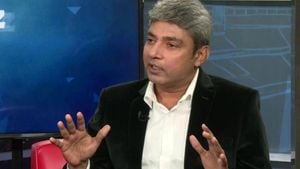Under President Donald Trump’s administration, significant changes are shaking the U.S. federal workforce, leaving thousands of employees grappling with uncertainty about their employment status. Amidst controversial cost-cutting measures and demands for accountability led by Elon Musk, the fallout is becoming increasingly noticeable across government agencies.
This shift began with ambitious plans to revamp how federal employees are managed. Trump expressed his support for Musk’s Department of Government Efficiency, as Musk tasked federal workers with detailing five accomplishments by Monday or face potential termination. Trump, meeting with French President Emmanuel Macron, emphasized Musk’s initiatives, saying, “What he’s doing is saying, ‘Are you actually working?’” He went on to assert, without evidence, claims of “hundreds of billions of dollars in fraud” related to nonexistent federal employees.
The new directive faced immediate backlash. Union representatives and advocates swiftly filed lawsuits, arguing Musk’s demand violates labor laws and undermines employee rights. Describing the potential firings as “one of the most massive employment frauds in the history of this country,” the State Democracy Defenders Fund spearheaded litigation aimed at blocking mass layoffs.
Many key agencies pushed back against Musk’s approach. For example, the State Department, FBI, and Department of Homeland Security instructed employees not to comply with the deadline. FBI Director Kash Patel framed the agency’s stance as one of protecting sensitive information and privacy, indicating friction between Musk’s aggressive oversight and the traditional operational protocols of federal agencies.
Confusion reigns as employees are caught between conflicting guidance. The Office of Personnel Management (OPM) originally sent out the email directive requiring responses by 11:59 p.m. EST on Monday, yet several agencies raised objections, questioning the legality and appropriateness of the demands. Lawmakers from both sides of the aisle expressed concerns about the legality of Musk’s mandate and the potential for violations of employee rights.
One federal employee, Mike Macans, recently fired from the Small Business Administration, shared his frustration at the chaotic firings, which he claimed left him without guidance on how to claim unemployment, or when his health insurance would be cut off. After learning of his termination, he swiftly found his access to systems locked, underscoring the disarray following the mass firings. He states, “They locked me out of all my systems. The only place I’ve gotten any help is online — on frickin’ Reddit.”
Another employee, whose hiring process felt hopeful after several years of military service, detailed the personal impact of this upheaval. “Never felt more betrayed,” Macans reflected, as he added his story to the growing chorus of those affected by the administration’s swift, and often disorganized, layoffs. Macans had been hired to navigate complex disaster recovery processes for Alaska, showcasing his dedication to government service, only to have it unceremoniously cut short.
The systematic layoffs align with Trump’s broader vision for reducing the size of government. This month-long purge has reportedly impacted hundreds of thousands of employees, as the president pushes for more dynamic and efficient operations, emphasizing accountability. Yet, the chaotic implementation raises alarms, particularly as overzealous demands from Musk may overlook the realities of government work and the intricacies involved.
Trump’s approach to federal employment echoes the management style seen at his private businesses, characterized by aggressive demands for efficiency. Musk, the billionaire entrepreneur who advises Trump on these initiatives, has become emblematic of this new wave of management philosophy. His assertion on social media echoed Trump’s sentiments: “Those who do not take this email seriously will soon be farthering their career elsewhere.”
The legal challenges, including suits from labor unions and advocacy groups, seek to impel broader changes to this sweeping strategy, arguing for protections for probationary employees who face abrupt termination without due process. With Trump seeking to trim the bureaucratic excess believed to be rampant, this clash between management tactics raises significant ethical and legal questions.
Public response has been varied. Some echo the frustrations voiced by union leaders and affected employees, advocating for common-sense reforms and protections against arbitrary firings. Meanwhile, others argue for the necessary changes to reinvigorate government operations. Yet, amid this debate lies the very real impact on families who have lost not just their jobs but their healthcare access and sense of security.
The growing discontent among employees is becoming increasingly evident. Office spaces, once filled with civil servants committed to their roles, now resemble sites of anxiety and conflict as workers wrestle with the uncertainty of job stability. Many are left feeling like pawns amid corporate-style maneuvering without adequate communication or support from their leaders.
Although the OPM continues to push forward with uncertain directives, the reality remains clear: the shake-up under Trump and Musk not only aims to reshape the government’s outer structure but delves deep, affecting the livelihoods and well-being of countless federal employees. With mass firings sweeping through agencies, the next steps remain increasingly unclear for those caught amid the turmoil.
The ramifications of these shifts extend beyond mere statistics, impacting the fundamental values of public service and governmental trust. Countless interviews reveal the sentiments of lost dedication and the fallout felt by families now grappling with the consequences of these chaotic changes. The struggle for clarity and purpose continues as the federal workforce navigates this challenging chapter.



